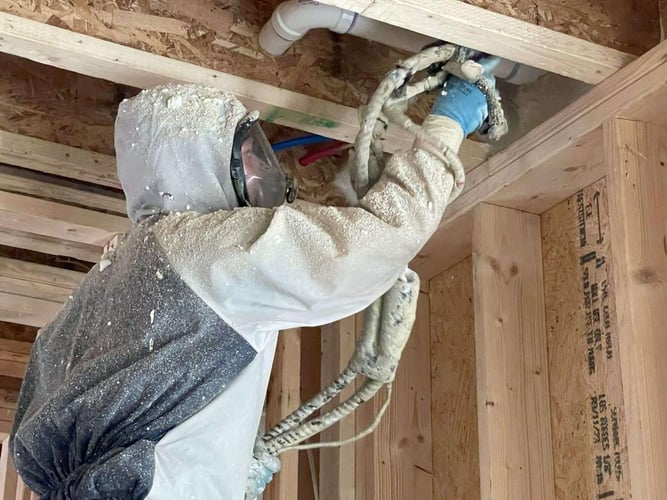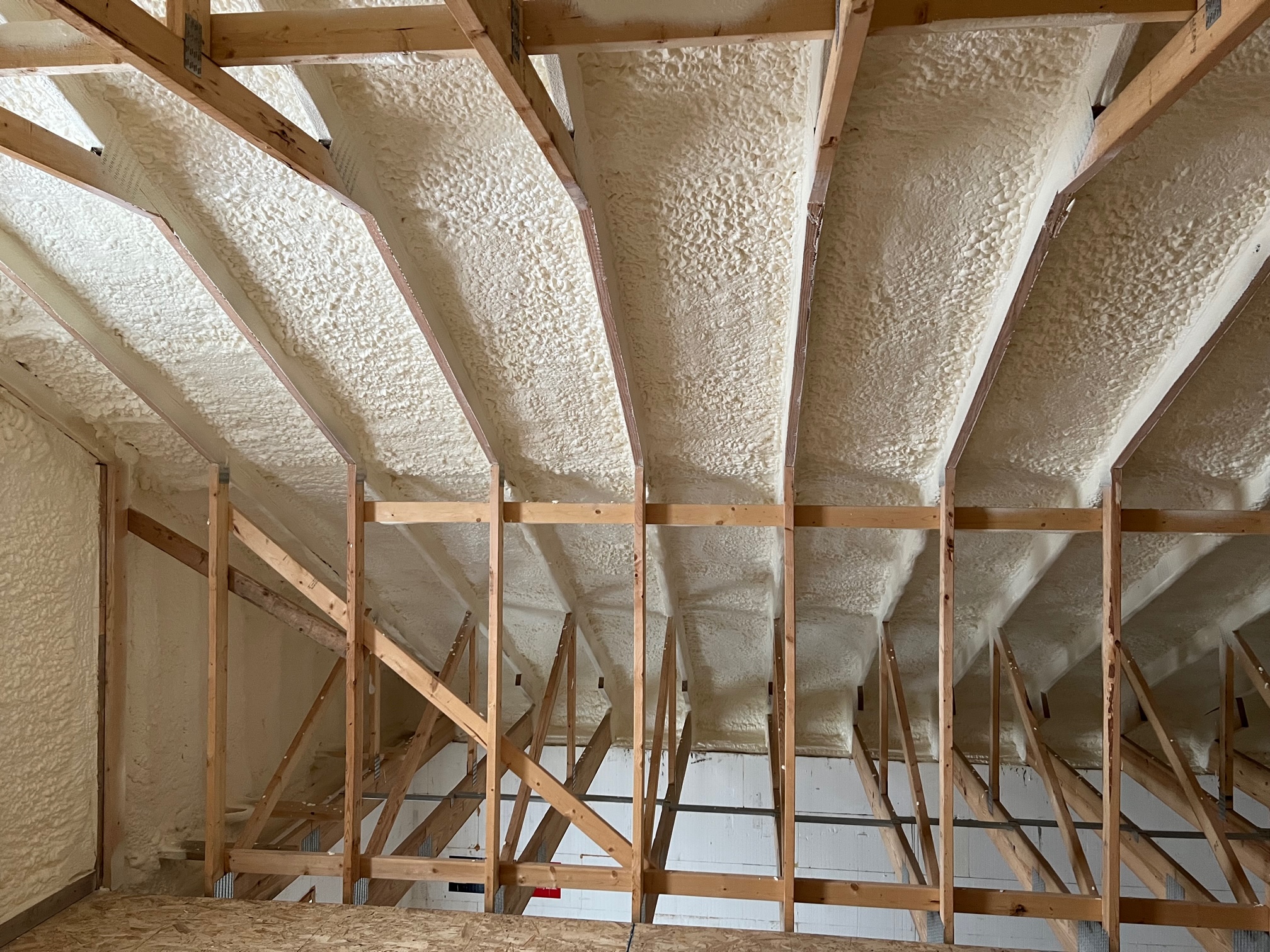Tips for Preserving Your Spray Foam Insulation for Long-Term Efficiency
Tips for Preserving Your Spray Foam Insulation for Long-Term Efficiency
Blog Article
Spray Foam: The Ultimate Solution for Air Sealing and Insulation
Spray foam insulation has actually emerged as a leading solution for effective air securing and thermal insulation, using a special combination of homes that set it apart from standard methods. Understanding the complete extent of its benefits, installation procedures, and comparisons with other insulation kinds is vital for making notified decisions.
What Is Spray Foam?
Spray foam is a functional insulation material that incorporates the concepts of air sealing and thermal resistance to boost power efficiency in structures. Composed primarily of polyurethane or other comparable compounds, spray foam is applied as a fluid that expands upon call with surfaces, developing a solid, continuous layer of insulation. This one-of-a-kind property enables it to fill voids, cracks, and voids that traditional insulation products may ignore, providing a premium air seal.
There are two major kinds of spray foam: open-cell and closed-cell. Open-cell spray foam is lighter and much more adaptable, supplying excellent noise absorption and a lower R-value per inch - Spray Foam. On the other hand, closed-cell spray foam is denser, giving a higher R-value, moisture resistance, and included structural integrity to developing parts
The application process normally includes specific equipment, making sure a seamless application that abides by numerous substrates, consisting of timber, concrete, and steel. This versatility makes spray foam appropriate for both brand-new buildings and retrofitting existing frameworks. Its capacity to produce a closed obstacle significantly contributes to reducing energy consumption and enhancing interior air quality, thus making it a favored selection amongst home builders and home owners alike.
Benefits of Spray Foam Insulation
Among one of the most substantial advantages of spray foam insulation is its phenomenal ability to create a continuous air barrier, which effectively reduces energy loss. Unlike typical insulation products, spray foam increases to load voids and splits, making sure that air leakage is significantly lowered. This characteristic not just enhances energy effectiveness yet also brings about decrease utility costs in time.
Additionally, spray foam insulation gives premium thermal resistance, adding to a more steady interior setting. Its high R-value per inch permits effective insulation in restricted rooms, making it ideal for attic rooms, wall surfaces, and crawl areas. The moisture-resistant homes of spray foam aid stop mold and mildew and mildew development, promoting much healthier living problems.
Another essential advantage of spray foam insulation is its sound-dampening high qualities (Spray Foam). It efficiently lowers noise transmission in between spaces, developing a quieter and a lot more comfy home environment. The durability of spray foam additionally stands apart, as it does not droop or settle with time, preserving its performance throughout its life-span
How Spray Foam Functions
Understanding exactly how spray foam insulation functions is important for appreciating its performance in air sealing and thermal resistance. Spray foam insulation contains two main parts: isocyanate and polyol resin. When these elements are blended, they undergo a chain reaction that triggers the material to broaden quickly, producing a thick foam that loads gaps, dental caries, and splits.
As the foam expands, it adheres to surfaces, forming an airtight seal that significantly reduces air seepage. This characteristic makes spray foam insulation highly reliable at protecting against drafts and wetness penetration, which can cause energy loss and damages in time. In addition, the closed-cell version of spray foam uses exceptional thermal resistance as a result of its inflexible framework, efficiently lessening warmth transfer.
The unique buildings of spray foam permit it to adapt uneven surfaces, making certain comprehensive coverage and a smooth barrier. Because of this, spray foam insulation not only boosts energy efficiency however also adds to boosted interior air top quality by decreasing the build-up of irritants and toxins. Ultimately, understanding the mechanics behind spray foam emphasizes its duty as a superior selection for insulation and air sealing in both property and business applications.
Installment Refine Overview

Before setup, the area has to be sufficiently cleansed and prepped, making certain that surfaces are devoid of dust, dampness, and particles. Due to the fact that impurities can compromise adhesion and overall performance, this step is essential. When the area is prepared, the application includes blending both components of the spray foam, which expands upon contact and fills gaps effectively.
Trained professionals must carry out the setup, using specific equipment to guarantee uniform coverage and optimum density. Safety and security safety measures, including wearing safety gear and ensuring correct air flow, are essential throughout this process. After application, the foam commonly treatments promptly, forming a solid obstacle that boosts power performance.
Contrasting Spray Foam to Conventional Insulation
When assessing insulation alternatives, spray foam insulation attracts attention in comparison to traditional products such as fiberglass and cellulose. One of the key advantages of spray foam is its superior air sealing capacities. Unlike fiberglass and cellulose, which can permit air infiltration, spray foam increases upon application, filling gaps and voids to develop a closed seal. This causes boosted energy performance, as much less warmed or cooled down air leaves the home, causing lower energy bills.
Additionally, spray foam offers a greater R-value per inch than typical insulation kinds, using even more reliable thermal resistance in a thinner profile. This characteristic is particularly beneficial precede with restricted dental caries deepness. In addition, spray foam is immune to wetness and mold and mildew development, which can be a considerable interest in cellulose and fiberglass, specifically in damp environments.
However, spray foam insulation usually brings a greater in advance expense than its traditional counterparts. Homeowners must evaluate this preliminary financial investment against long-term energy savings and performance benefits. Inevitably, while both insulation kinds serve their function, spray foam becomes an advanced solution for modern-day insulation requirements, particularly in terms of air securing and thermal performance.

Conclusion
In summary, spray foam insulation stands for a highly effective option for attaining ideal air securing and thermal resistance. Its distinct buildings, consisting of wetness resistance and sound discover this dampening, make it ideal for numerous applications in both brand-new buildings and retrofitting jobs (Spray Foam). Although the initial costs may be higher compared to typical insulation materials, the lasting benefits, such as substantial energy cost savings and enhanced indoor air high quality, validate the financial investment and highlight its worth in modern building techniques.
Spray foam insulation has arised as a leading option for effective air securing and thermal insulation, providing an unique mix of residential properties that establish it apart from traditional approaches.Spray foam is a versatile insulation product that combines the concepts of air securing and thermal resistance to enhance power efficiency in buildings.When reviewing insulation options, spray foam insulation stands out in comparison to traditional products such as fiberglass and cellulose. Ultimately, while both insulation types offer their click here for more objective, spray foam emerges as a much more innovative solution for contemporary insulation needs, especially in terms of air securing and thermal efficiency.
In summary, spray foam insulation stands for a very effective service for attaining optimum air sealing and thermal resistance.
Report this page